Grooming Tips From a Trainer’s Perspective
by Hillary Alpert
There are 3 professionals many dogs encounter in their lives: their veterinarian, their dog trainer and… their groomer!
Most veterinarians say the groomer is the most important person in the dog’s life-after the family, of course. The groomer has their hands all over the dog and sees them regularly so they often notice health ailments easier than most. So, it’s really helpful for your dog, groomer, and you to all be comfortable with the experience of getting trimmed and cleaned. Even if your dog doesn’t go to a groomer for a “haircut”, everything you read here can be applied to a bather, or other care professionals that may handle your dog “up close and personal”.
Let’s look at it from a behavioral perspective to start: why are dogs often so afraid of the groomer?
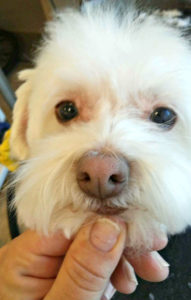
Going to the groomer can be an overwhelming experience. There are loud noises, sharp objects, barking from all of the dogs that may be in the salon, and the hustle and bustle of dogs going in and out. Add on top of that, owners often exude anxiety that increases the dog’s unease. The best thing we can do is introduce our puppies and dogs to the experience slowly and make it a positive outcome. This training can start at home.
First, meet your groomers! Before bringing Fido in for a trim, go say hello and make friends. As we discuss in our program (beginning in the very first phase of study), socialization is key to a growing pup’s life. Go on in to your groom shop (whether private or corporate) and say hello. Shake hands and let your dog meet the groomer (make sure to bring lots of tasty treats to make it even better and more memorable experience).
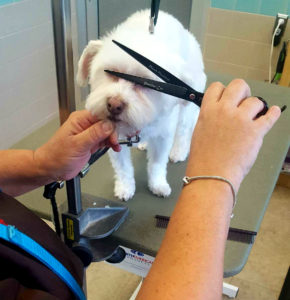
Now it’s time to go home and get your dog prepped for the experience. Start when it’s quiet and your dog is relaxed. Touch him everywhere. Give him treats. Don’t be afraid to pick up his feet, touch his nails, ears, face, and tail. If he fusses or struggles, don’t increase your pressure or force it, but don’t stop completely – take it light and slow and let him know this is great! (Remember to share those treats!) Start with short sessions and practice every day, multiple times if you can. Hold up his ears or hold on gently to the chin hair. Hold his feet and tail. Hold up his belly and reward him greatly!
Slowly, start to introduce the brush and comb to your arsenal of touches. First, let your dog investigate and sniff (not chew!) and slowly start to run the brush/comb over the dog. If he gets huffy and goes after it, distract him with something else like a treat or toy. Keep these sessions quick and slowly add on more time.
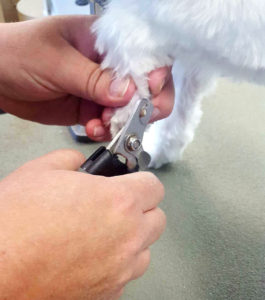
Work on holding paws up and touching the nails. At first, it is great to use a metal spoon and run it over the dog – especially on the feet and around the face (these are sensitive are
as but are also the most common places that will get scissored during a grooming session). Again, don’t get frustrated if the dog gets upset. Use distractions and rewards to keep him engaged in the game aspect of this. For example, pick one body part then touch and treat, touch and treat, touch and treat. You will find that if you are gentle and quick enough, soon the dog may be offering to lift that paw for you, or move closer for you to lift her ear up!
Visit your groomer and show in your body language and attitude that you’re comfortable with dropping him off. Your dog will feed off of you, so don’t over-coddle, but be reassuring by being yourself. Many pet owners believe their dog won’t be okay without you: take it from a groomer, they usually are. Don’t be afraid to leave treats with your groomer and then go! . Some groomers will tell an owner it can take several hours, and that’s normal. They want to get the process done safely and if your dog needs breaks, good groomers will give them.
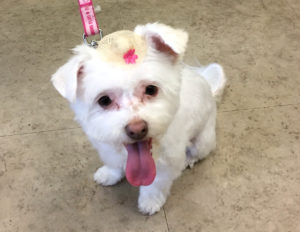 Once the dog is all set, you can pick up your pooch and get a great report card! If a dog is on a schedule to be groomed regularly, it becomes a part of life as opposed to an overwhelming event. Some dogs even love coming by and visiting their groomer. Especially those that were prepped using the approach given here. The younger you start with these techniques, the better.
Once the dog is all set, you can pick up your pooch and get a great report card! If a dog is on a schedule to be groomed regularly, it becomes a part of life as opposed to an overwhelming event. Some dogs even love coming by and visiting their groomer. Especially those that were prepped using the approach given here. The younger you start with these techniques, the better.
As a dog trainer, you can prep clients for a pleasant grooming experience. Using these steps will help dogs become ready for “the big show” at the salon, where they can have an easy going, low stress experience.
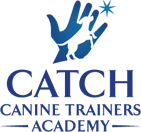




 Once the dog is all set, you can pick up your pooch and get a great report card! If a dog is on a schedule to be groomed regularly, it becomes a part of life as opposed to an overwhelming event. Some dogs even love coming by and visiting their groomer. Especially those that were prepped using the approach given here. The younger you start with these techniques, the better.
Once the dog is all set, you can pick up your pooch and get a great report card! If a dog is on a schedule to be groomed regularly, it becomes a part of life as opposed to an overwhelming event. Some dogs even love coming by and visiting their groomer. Especially those that were prepped using the approach given here. The younger you start with these techniques, the better.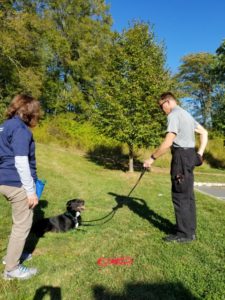




 Phone:
Phone: